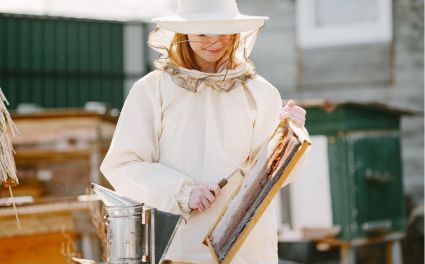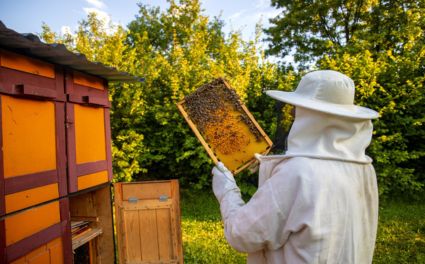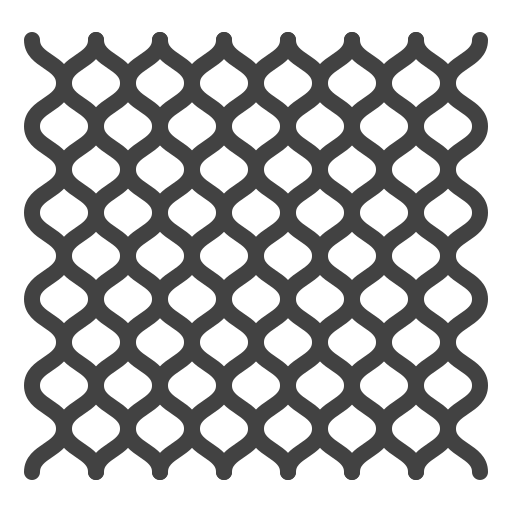L'entretien de vos combinaisons et équipements d'apiculteur est essentiel pour garantir sécurité et longévité. Un entretien approprié prolonge non seulement la durée de vie de votre équipement, mais vous protège également lorsque vous travaillez avec vos abeilles. Dans ce guide, nous aborderons les meilleures pratiques pour nettoyer, inspecter et ranger votre matériel d'apiculture.
Nettoyage des combinaisons d'apiculteur
Méthodes de nettoyage des combinaisons d'apiculteur
Un nettoyage régulier de vos combinaisons d'apiculteur est essentiel pour éliminer la saleté, la transpiration et les contaminants potentiels. Pour la plupart des combinaisons, un lavage à la main avec une lessive douce est recommandé afin de préserver l'intégrité du tissu. Si vous préférez le lavage en machine, utilisez un cycle délicat et de l'eau froide pour éviter tout dommage. Évitez toujours l'eau de Javel ou les produits chimiques agressifs qui pourraient dégrader le tissu.
Éliminer les taches et les odeurs
Au fil du temps, votre combinaison d'apiculteur peut accumuler des taches et des odeurs. Pour éliminer les taches tenaces, utilisez des solutions naturelles comme le bicarbonate de soude ou le vinaigre. Ces solutions sont efficaces et sans danger pour le tissu. Appliquez simplement la solution sur la zone tachée, laissez agir un moment, puis lavez comme d'habitude. Pour les odeurs, un mélange d'eau et de vinaigre peut être vaporisé sur la combinaison avant le lavage afin de neutraliser les mauvaises odeurs.
Inspection et réparation des combinaisons d'apiculteur
Inspections régulières
Des inspections régulières de vos combinaisons d'apiculteur sont essentielles pour identifier tout dommage susceptible de compromettre votre sécurité. Vérifiez l'absence de déchirures, d'usures et de fermetures éclair ou d'attaches cassées. En traitant ces problèmes rapidement, vous garantissez que votre combinaison reste protectrice et fonctionnelle.
Réparation des combinaisons d'apiculteur
Les petits dommages, comme les petites déchirures ou les coutures décousues, peuvent souvent être réparés à la maison avec une aiguille et du fil. Pour des réparations plus importantes, pensez à consulter un professionnel ou à acheter des pièces de rechange. Si votre combinaison est très endommagée, il est peut-être temps d'en acheter une nouvelle pour assurer une protection continue.
Nettoyage et stockage du matériel d'apiculture
Nettoyage du matériel d'apiculture
Votre matériel apicole, y compris les outils de la ruche, les enfumoirs et les cadres, doit être nettoyé régulièrement pour prévenir la propagation des maladies et des parasites. Utilisez une brosse métallique ou un grattoir pour éliminer toute accumulation de propolis et de cire. Pour un nettoyage en profondeur, lavez le matériel à l'eau chaude avec un détergent doux. Assurez-vous que tout soit parfaitement sec avant de le ranger afin d'éviter la rouille et la moisissure.
Stockage du matériel apicole
Un bon rangement de votre matériel apicole est crucial pendant la saison morte. Rangez vos outils dans un endroit sec et frais pour éviter la rouille et les dommages. Pensez à utiliser des contenants hermétiques pour protéger les cadres et autres pièces en bois des nuisibles comme les fausses teignes. Recouvrir les objets plus volumineux avec des bâches de protection peut également les protéger de la poussière et du soleil.
Protection des combinaisons et du matériel d'apiculteur contre l'usure
Mesures de protection
L'utilisation de housses de protection et de solutions de rangement dédiées peut prolonger considérablement la durée de vie de vos combinaisons et équipements d'apiculteur. Rangez votre combinaison dans une housse respirante pour la protéger de la poussière et des UV. Rangez vos outils dans une boîte à outils ou un bac de rangement pour éviter toute usure inutile.
Utilisation appropriée
L'utilisation de vos combinaisons et équipements d'apiculteur peut également influencer leur longévité. Évitez de traîner vos outils par terre ou d'exposer votre combinaison à des produits chimiques agressifs. Manipulez toujours votre équipement avec soin et suivez les instructions du fabricant pour éviter toute usure prématurée.

Améliorer vos combinaisons et équipements d'apiculteur
Quand effectuer une mise à niveau
Même avec les meilleures pratiques d'entretien, il viendra un moment où vous devrez renouveler vos combinaisons et équipements d'apiculteur. Une usure importante, des taches persistantes ou tout dommage compromettant la sécurité sont des signes avant-coureurs. L'utilisation de matériaux plus récents et plus durables peut offrir une meilleure protection et un meilleur confort.
Choisir des remplacements de haute qualité
Lors du choix de vos nouvelles combinaisons et équipements d'apiculteur, privilégiez des caractéristiques clés telles que la durabilité, la respirabilité et la facilité d'utilisation. Les marques de confiance proposent souvent des produits de haute qualité qui résistent aux rigueurs de l'apiculture. Investir dans un équipement fiable vous assure protection et efficacité dans vos activités apicoles.
Outre l'entretien de votre matériel apicole, il est essentiel de vous assurer que votre équipement de protection est conforme aux normes. OZ Armour propose une collection haut de gamme de «Combinaison d'apiculture et Gants d'apiculture" conçu pour une sécurité et un confort maximum.
Nos combinaisons et gants d'apiculteur offrent une excellente protection contre les piqûres d'abeilles tout en offrant une grande liberté de mouvement lors des inspections des ruches et de la récolte du miel. Fabriqués à partir de matériaux durables et respirants, nos combinaisons et gants vous assurent confort et protection tout au long de vos activités apicoles. Que vous soyez apiculteur débutant ou expérimenté, la collection OZ Armour répond à tous vos besoins et optimise votre expérience apicole.
Conclusion
L'entretien de vos combinaisons et équipements d'apiculteur est essentiel pour garantir sécurité et durabilité. Un nettoyage régulier, des inspections et un stockage approprié prolongent la durée de vie de votre équipement et garantissent une protection efficace.
En effectuant rapidement les petites réparations et en sachant quand les remplacer, vous pouvez maintenir votre équipement en parfait état. En combinant ces pratiques avec du matériel de haute qualité, Armure OZ vous assure de rester protégé et confortable pendant l'apiculture.
Notre collection de combinaisons et de gants d'apiculteur est conçue pour une sécurité et une facilité d'utilisation maximales, rendant votre expérience apicole plus efficace et agréable. Privilégiez l'entretien pour préserver votre investissement et assurer la prospérité de votre rucher.












